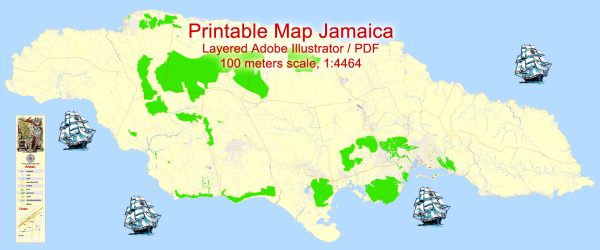A general overview of Jamaica’s infrastructure. Vectormap.Net provide you with the most accurate and up-to-date vector maps in Adobe Illustrator, PDF and other formats, designed for editing and printing. Please read the vector map descriptions carefully. Here is an overview of key aspects of Jamaica’s infrastructure:
1. Transportation:
- Roads: Jamaica has an extensive road network, including highways and local roads. Major highways connect key cities, but road conditions can vary.
- Public Transportation: Public transportation primarily consists of buses and taxis. Kingston, the capital, has a bus system, and taxis are widely used across the island.
- Airports: Norman Manley International Airport in Kingston and Sangster International Airport in Montego Bay are the major international airports. There are also several smaller domestic airports.
2. Ports and Shipping:
- Jamaica has several major seaports, including the Port of Kingston and the Port of Montego Bay. These ports play a crucial role in trade and transportation.
3. Energy:
- The energy sector in Jamaica has undergone changes to incorporate renewable sources. The country has invested in wind and solar energy projects to diversify its energy mix.
- The Jamaica Public Service Company (JPS) is the primary electricity provider.
4. Telecommunications:
- Jamaica has a well-developed telecommunications infrastructure. Multiple providers offer mobile and internet services across the island.
- Internet connectivity has expanded, and there is increasing access to broadband services.
5. Water and Sanitation:
- The National Water Commission (NWC) is responsible for water supply and distribution. Access to clean water can vary in rural areas.
- Efforts are made to improve sanitation and sewage systems, but challenges persist in some regions.
6. Education and Healthcare Facilities:
- Jamaica has a network of schools and universities providing education services. The University of the West Indies is a notable institution.
- Healthcare facilities include hospitals and clinics. The Ministry of Health and Wellness oversees healthcare services.
7. Housing:
- Housing varies from urban to rural areas. Informal settlements exist, and the government has implemented programs to address housing challenges.
8. Tourism Infrastructure:
- Tourism is a vital sector, and infrastructure supports this industry. Hotels, resorts, and entertainment facilities cater to both international and domestic tourists.
9. Disaster Preparedness:
- Jamaica faces natural disasters such as hurricanes. The government has initiatives in place for disaster preparedness and response.
10. Development Projects:
- Various development projects have been initiated to enhance infrastructure, including road construction, airport expansions, and energy diversification.
It’s important to note that infrastructure development is an ongoing process, and the information provided here may have changed. For the latest and more detailed information, you may want to refer to official government reports, infrastructure agencies, or other reliable sources.


 Author: Kirill Shrayber, Ph.D.
Author: Kirill Shrayber, Ph.D.